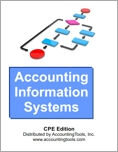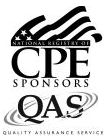Accounting Information Systems (CPE Course)
CPE Credit: 13 hours
Course Type: Downloaded PDF materials with online test
Price (with PDF Textbook): $90
Course Description
The practicing accountant should have a thorough knowledge of the processes within an accounting system. Otherwise, it would not be possible to create a system of controls, write procedures, understand where errors are originating, or develop new systems. The Accounting Information Systems course provides the deep background needed to gain proficiency in this area. In addition, there is significant treatment of the many controls integrated into accounting systems. Finally, the course describes the key events in the process of developing and installing a new system. In short, this course is the essential source for the accountant who wants to understand the core functions of an accounting information system.
Author: Steven Bragg
Course Number: AC1129
Table of Contents
Chapter 1. Overview of Accounting Information Systems
Chapter 2. Transaction Processing
Chapter 3. System Documentation
Chapter 4. Databases
Chapter 5. Systems-Related Fraud and Theft
Chapter 6. Systems of Control
Chapter 7. Information System Controls
Chapter 8. Auditing Accounting Information Systems
Chapter 9. The Sales Cycle
Chapter 10. The Expenditure Cycle
Chapter 11. The Production Cycle
Chapter 12. The Human Resources Cycle
Chapter 13. Financial Reporting
Chapter 14. Systems Development and Analysis
Learning Objectives
Recognize the components of an accounting information system, and how it can be used.
Identify the characteristics of data.
Recognize different types of business processes.
Describe the nature of a give-get exchange.
Describe the data processing cycle.
Recognize different types of source documents.
Differentiate between the different types of ledgers and their contents.
Specify where accounts are categorized within the chart of accounts.
Specify the uses to which a context diagram can be put.
Identify the best practices associated with the development of data flow diagrams and flowcharts.
Recognize the different types of data representation in a database.
State how tables and fields within a database are described.
Describe the advantages of a relational database.
Identify the tools used to manipulate and investigate data.
Describe the legal basis for fraud having been perpetrated.
Describe the three elements of the fraud triangle.
Identify the conditions that should be present in order to reduce the incidence of fraud.
Recognize the different classifications of computer-related fraud.
Specify the conceptual failings that can interfere with a system of controls.
Identify the different classifications of controls.
State the organizations supporting the Committee of Sponsoring Organizations.
Describe the components of the Internal Control – Integrated Framework and the Enterprise Risk Management framework.
Identify the domains included in the COBIT model.
Recognize the different types of directed attacks to which a system may be subjected.
Identify the different types of input controls.
State the privacy principles noted in the Generally Accepted Privacy Principles.
Describe the different types of data backups.
Recognize the characteristics of a digital signature.
Describe the contents of an audit plan.
Identify the techniques used to collect audit evidence.
Describe the advantages of using computer-assisted auditing.
Recognize the components of the sales cycle and the failures that can arise from having incorrect data in it.
Identify the flow of information through the sales cycle, as well as the use of various documents within it.
Recognize the components of the expenditure cycle and the failures that can arise from having incorrect data in it.
Describe the formula for calculating the amount of reserve stock.
Identify the concepts underlying a just-in-time system.
Identify the various documents used in the expenditure cycle.
State the reasoning behind using the target costing system.
Recognize the components of the production cycle and the failures that can arise from having incorrect data in it.
Identify the components of the master production schedule.
Describe the different types of best practices that may be incorporated into an advanced manufacturing environment.
Identify the key components of an activity-based costing system.
Recognize the components of the human resources cycle and the failures that can arise from having incorrect data in it.
Identify the various documents and reports used in the human resources cycle.
Specify the situations in which the use of incentive compensation software is warranted.
Describe the responsibilities of an employer and its supplier when payroll is outsourced.
Identify the contents of the financial statements.
Recognize the formatting changes that can be used to enhance the relevance of reported information.
Identify the different types of month-end adjusting entries.
Describe the advantages of using long-term systems planning.
Specify the actions that can be taken to improve the odds of completing a system installation.
Recognize the levels of in-house expertise needed to operate different types of software installations.
Level: Overview
Instructional Method: QAS Self-Study
NASBA Category: Accounting
Prerequisites: General knowledge of the accounting for sales, payables, payroll, and fixed assets, as well as the production of financial statements.
Advance Preparation: None
Latest Review Date: November 2024
Program Registration Requirements: Click on "Purchase Course" near the top of this page to pay for and access the course. You will then be able to download the course as a PDF file, then take an on-line examination, and then download a certificate of completion if you pass the examination.
Program Refund Policy: For more information regarding administrative policies concerning complaints, refunds, and other matters, see our policies page.
AccountingTools, Inc. is registered with the National Association of State Boards of Accountancy (NASBA) as a sponsor of continuing professional education on the National Registry of CPE Sponsors. State boards of accountancy have the final authority on the acceptance of individual courses for CPE credit. Complaints regarding registered sponsors may be submitted to the National Registry of CPE Sponsors through its website: www.nasbaregistry.org.
The NASBA sponsor identification number for Accountingtools, Inc. is 115881.
AccountingTools is an IRS Approved Continuing Education Provider. We are compliant with the requirements for continuing education providers (as described in sections 10.6 and 10.9 of the Department of Treasury’s Circular No. 230 and in other IRS guidance, forms, and instructions). Our IRS Approved Continuing Education Provider number is 72821.


